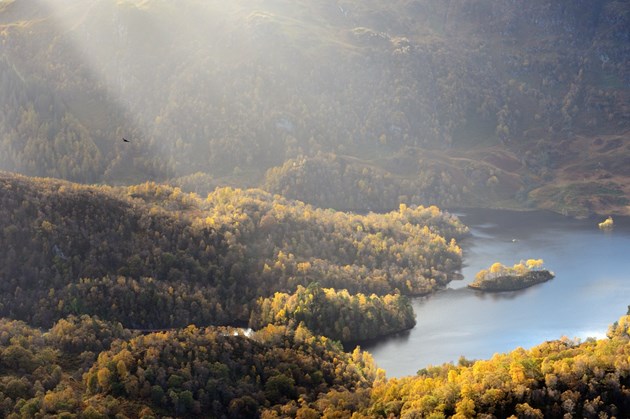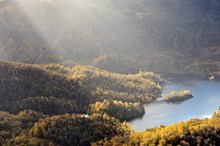09 April, 2019
Vital benefits of Scotland’s nature now increasing year on year

The values of Scotland’s plants, wildlife, air, water, and land – known as natural capital – are now officially increasing for the first time, and delivering stronger benefits to people and businesses across Scotland than in the previous two decades.
Scotland’s Natural Capital Asset Index (NCAI) assesses the quality and quantity of our land-based habitats and their contributions to human wellbeing.
This year’s study shows that the quality of all habitat types is improving, including places such as heathlands – our most widespread habitats – and peatlands, which have the greatest potential to contribute to human wellbeing, by storing significant volumes of carbon and helping combat climate change.
Scotland’s woodlands are also now expanding annually, with broadleaved woodland habitat 40% larger than in 2000, and woodland bird numbers increasing by 25% over the same period.
Welcoming the update, Environment Secretary Roseanna Cunningham said: “Scotland became the first country in the world to publish a detailed report which monitors annual changes in its natural capital and it is encouraging to see that the contribution nature makes to our society has continued to improve since the index first launched in 2011.
"Research shows that more than 75% of businesses now recognise the huge importance of Scotland’s natural capital to their operations.”
Our natural capital has shown signs of recovery for five consecutive years and is now at its highest level since 2000 after decades of decline between the 1950s and 1990s, due to human activities such as increases in peat drainage and uses of pesticides.
SNH Chief Executive Francesca Osowska said: “It’s excellent news that our natural capital is now officially increasing for the first time.
"Natural capital is vitally important for Scotland’s economy and our quality of life. It provides us with food, water, natural flood defences and crop pollination.
"At SNH we are working to protect and enhance our wildlife and habitats, helping to ensure our natural capital continues its recovery of recent years.
“There remain many challenges, not least from climate change, and we are working to address these, to make Scotland a better place for future generations to live, work, and visit.”
To give a fuller picture of the country’s natural capital, plans are underway to include the contribution made by Scotland’s marine environment in future years. SNH estimates that marine habitats around Scotland store more than 2,000 million tonnes of carbon, which studies show to be equivalent to around 200 years of our current carbon emissions.
This year SNH has presented the results in a user-friendly StoryMap. The index, its accompanying technical note and information summary are available to explore on SNH’s website here.
Contact information
- Name
- NatureScot Media
- Telephone
- 0131 316 2655
- media@nature.scot
Notes to editors
The NCAI is a composite index which tracks changes in the capacity of Scotland’s terrestrial ecosystems to provide benefits to people. It is not a monetary value but is composed in a way which reflects the relative contribution of habitats to human wellbeing.
The capacity of ecosystems to provide benefits fluctuates over time due to changes in habitat quantity and quality. Habitat quantity is tracked using what we know about land cover change in Scotland. Habitat quality is tracked using 38 separate indicators which rely on datasets gathered by a range of public organisations and citizen science schemes.
The index tracks the changes in Scotland’s land-based ecosystems and shows the benefits of natural capital to our provisioning services such as crops; regulating and maintenance services such as pollination and water filtration, and cultural services such as recreation and aesthetics. As an indicator the NCAI is continuously developing; future updates could see an inclusion of the marine environment and a better estimation of nature’s less tangible contributions, such as aesthetic beauty and cultural heritage.
The Scottish Government and the UK Office for National Statistics have recently released experimental natural capital accounts for Scotland. A full explanation of the differences between the two can be found in our comparison document.
Scottish Natural Heritage is the government's adviser on all aspects of nature and landscape across Scotland. Our role is to help everyone understand, value and enjoy Scotland's nature now and in the future. For more information, visit our website at www.nature.scot . SNH media is also on Twitter at http://twitter.com/nature_scot
NatureScot is Scotland's nature agency. We work to enhance our natural environment in Scotland and inspire everyone to care more about it. Our priority is a nature-rich future for Scotland and an effective response to the climate emergency. For more information, visit our website at www.nature.scot or follow us on X at https://x.com/NatureScot
’S e NatureScot buidheann nàdair na h-Alba. Bidh sinn a’ neartachadh àrainneachd na h-Alba agus a’ brosnachadh dhaoine gu barrachd suim a chur ann an nàdar. Tha e mar phrìomhachas againn gum bi nàdar na h-Alba beairteach agus gun dèilig sinn gu h-èifeachdach le èiginn na gnàth-shìde. Tha an tuilleadh fiosrachaidh aig www.nature.scot no air X aig https://x.com/NatureScot

